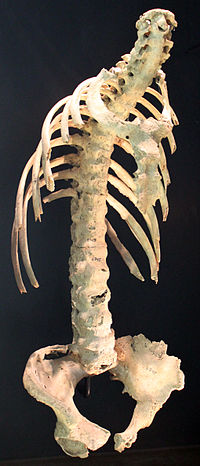
Photo from wikipedia
Objectives To analyse the effect of tumour necrosis factor inhibitors (TNFi) on sacroiliac joint (SIJ) radiographic progression in axial spondyloarthritis (axSpA). Methods Patients with axSpA in the Swiss Clinical Quality… Click to show full abstract
Objectives To analyse the effect of tumour necrosis factor inhibitors (TNFi) on sacroiliac joint (SIJ) radiographic progression in axial spondyloarthritis (axSpA). Methods Patients with axSpA in the Swiss Clinical Quality Management cohort with up to 12 years of follow-up and radiographic assessments every 2 years were included. SIJs were scored by two readers according to the modified New York criteria blinded to chronology. The relationship between TNFi use before or during a 2-year radiographic interval and SIJ progression was investigated using generalised estimating equation models with adjustment for potential confounding. Progression was defined as worsening of ≥1 grade in ≥1 SIJ and ignoring a change from 0 to 1 over 2 years, if both readers agreed. A third reading of radiographs was integrated in sensitivity analyses. Results A total of 515 patients with axSpA contributed to data for 894 radiographic intervals (24 progression events). In patients with complete covariate data, prior use of TNFi reduced the odds of progression (OR 0.21, 95% CI 0.07 to 0.65). A comparable effect was found for use of TNFi for ≥1 year within a 2-year radiographic interval (OR 0.21, 95% CI 0.08 to 0.55). The inhibitory impact of TNFi was confirmed if progression was demonstrated in 2/3 readings: OR 0.50, 95% CI 0.28 to 0.89 and OR 0.46, 95% CI 0.27 to 0.78 for TNFi treatment before and for ≥1 year within the interval, respectively. Conclusion TNFi are associated with deceleration of SIJ radiographic progression in patients with axSpA if treatment is continued for ≥1 year.
Journal Title: RMD Open
Year Published: 2022
Link to full text (if available)
Share on Social Media: Sign Up to like & get
recommendations!